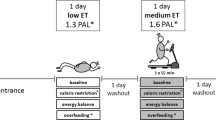Abstract
BACKGROUND: The physical activity pattern in society has in recent years changed from necessary occupational activity to voluntary activities during leisure-time. How this change in lifestyle affects the selection of dietary intakes is presently unknown.
OBJECTIVES: The aim of the present study was to investigate the different effects of high vs low-intensity exercise on the following day's dietary energy intake and macronutrient selection.
DESIGN: The study was designed as a controlled randomized cross-over study which compared food selection and energy intake the day following a low-intensity vs a high-intensity exercise bout. We included 32 healthy normal-weight subjects of four subgroups (young males, young females, old males and old females). On two different occasions they performed either 60 min low-intensity (30% of V˙O2max) or 30 min high-intensity (60% of V˙O2max) exercise during 24 h measurements of energy expenditure. The energy intake and macronutrient selection of the subsequent day was assessed by offering them an ad libitum buffet at breakfast and at lunch.
RESULTS: Following the low-intensity exercise the subjects chose a diet with an energy percentage from fat similar to that of their habitual diet—36.7% (95% CI: 34.3, 39.0) vs 35.6% (95% CI: 33.0, 38.2; NS). Following the high-intensity exercise they chose a diet with 39.9% (95% CI: 37.2, 42.6) fat, which was 3.2% (95% CI: 0.6, 5.9) higher than following the low-intensity exercise (P0.05) and 4.2% (95% CI: 1.1, 7.4) more than their habitual diet (P<0.01).
CONCLUSIONS: The present study shows that changing the type of activity of a single exercise bout from 30% of maximal aerobic capacity for 60 min to 60% for only 30 min resulted in consumption of a diet the following day with a higher fat energy percentage compared with the diet selected after the low-intensity exercise. However, the higher fat content diet did not result in a higher energy intake.
This is a preview of subscription content, access via your institution
Access options
Subscribe to this journal
Receive 12 print issues and online access
$259.00 per year
only $21.58 per issue
Buy this article
- Purchase on Springer Link
- Instant access to full article PDF
Prices may be subject to local taxes which are calculated during checkout
Similar content being viewed by others
Author information
Authors and Affiliations
Corresponding author
Rights and permissions
About this article
Cite this article
Klausen, B., Toubro, S., Ranneries, C. et al. Increased intensity of a single exercise bout stimulates subsequent fat intake. Int J Obes 23, 1282–1287 (1999). https://doi.org/10.1038/sj.ijo.0801074
Received:
Revised:
Accepted:
Published:
Issue Date:
DOI: https://doi.org/10.1038/sj.ijo.0801074
Keywords
This article is cited by
-
Post-exercise energy load and activities may affect subsequent ad libitum energy intake
International Journal of Obesity (2014)
-
Fat burn today, fat yearn tomorrow
Nature (2000)


